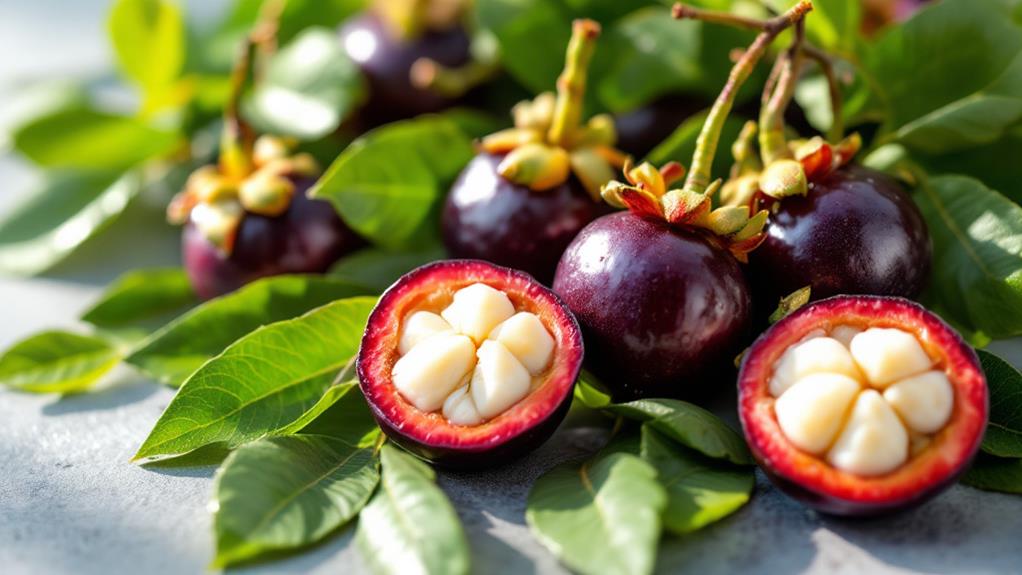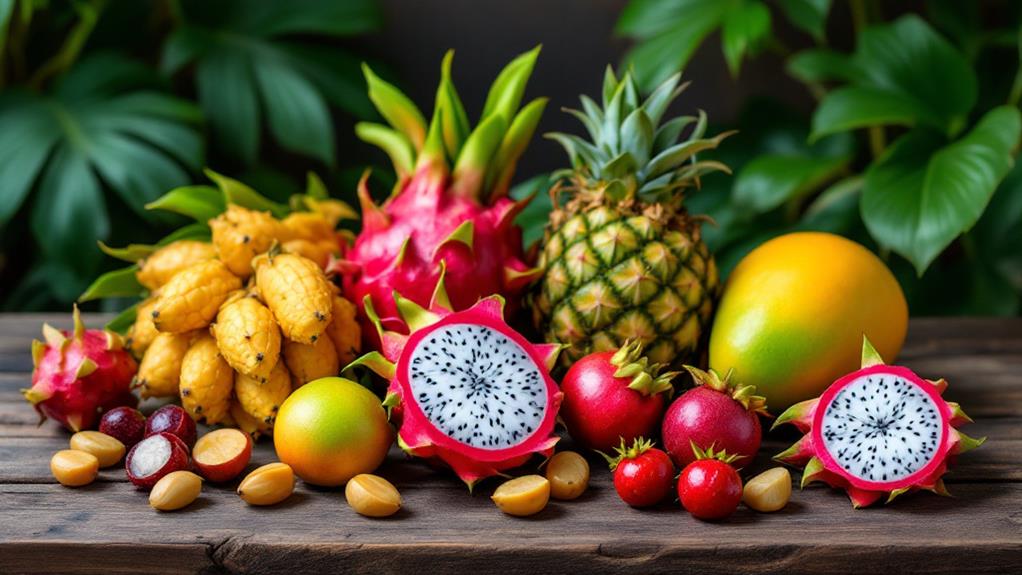Strange-Looking Fruits From Around the World: What Are They?
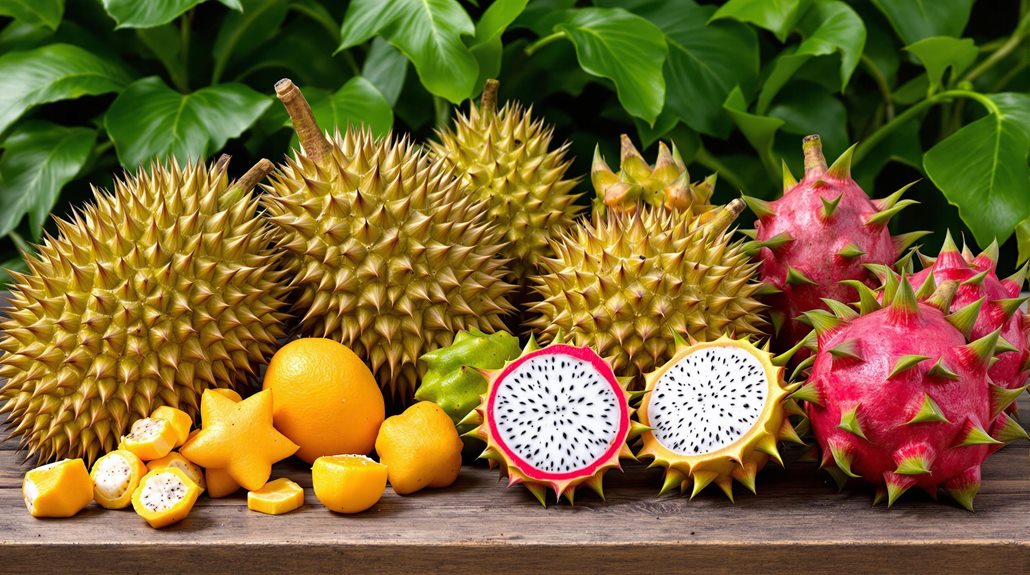
You're in for a treat with strange-looking fruits from around the world. Take the durian, nicknamed the "king of fruits," infamous for its pungent aroma but creamy, savory taste. Rambutan surprises with its hairy exterior, while dragon fruit grabs attention with its bright pink and green scales. There's the massive jackfruit, capable of weighing up to 100 pounds, and mangosteen, the "queen of fruits" with its luscious white segments. Snake fruit boasts scaly skin, Buddha's hand captivates with its finger-like tips, and horned melon intrigues with its spiky surface. Each offers a unique story and flavor to uncover.
Durian: The King of Fruits
With regard to fruits, durian stands out both for its unique appeal and its notorious reputation. Known as the "king of fruits," durian is celebrated for its distinctive taste and high nutritional value. It's rich in vitamins C, B, and dietary fiber, making it a nutritious choice. However, what truly sets this tropical fruit apart is its strong odor, often likened to rotten onions or turpentine. This smell is so potent that some places, like Singapore's subways, have banned it.
When you explore beyond the smell, you'll find durian's creamy flesh, offering a taste that's both sweet and savory. This unique flavor profile divides opinions; some people are passionate fans, while others are detractors. If you're adventurous, you might enjoy its custard-like texture and the complex blend of flavors. Originating from Southeast Asia, particularly in countries like Malaysia and Thailand, durian is not just a fruit but a celebrated delicacy.
Beyond eating it fresh, durian is also popular in desserts, such as ice creams and pastries. Weighing up to 7 pounds, this tropical fruit is a substantial treat with a distinctive presence.
Rambutan's Hairy Exterior
Rambutan's striking appearance immediately catches your eye with its hairy red exterior, which stands out among other fruits. This tropical fruit, native to Southeast Asia, boasts an unusual look with its spiky skin that resembles a cluster of soft spikes or hair. In fact, the name "rambutan" means "hairy" in Malay, aptly describing its distinctive appearance. Once you peel away this exotic fruit's hairy exterior, you'll find a sweet white pulp inside, similar in taste to grapes. This makes rambutan a popular choice for fresh consumption and desserts.
Not only does rambutan delight your taste buds, but it also provides nutritional benefits. Rich in vitamin C and antioxidants, this tropical fruit contributes to a healthy diet, offering both flavor and health benefits. As rambutan gains popularity in international markets, its unusual look continues to intrigue and tempt fruit lovers worldwide.
Here's a quick comparison of rambutan's features:
| Feature | Description |
|---|---|
| Exterior | Hairy red, spiky skin |
| Interior | Sweet white pulp |
| Origin | Southeast Asia |
| Nutritional Value | High in vitamin C and antioxidants |
| Popularity | Increasing globally |
With its unique appearance and delicious taste, rambutan offers an exciting experience for adventurous fruit enthusiasts.
Dragon Fruit's Vibrant Colors
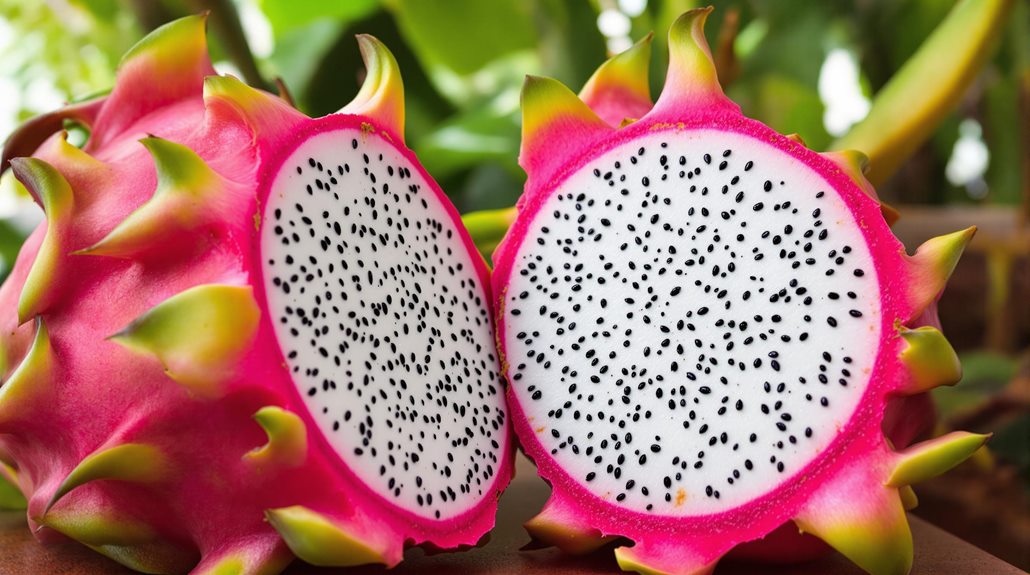
Amidst a sea of ordinary fruits, dragon fruit, or pitaya, stands out with its striking colors and unique appearance. Its bright pink skin, often adorned with green scales, gives it an exotic allure that's hard to resist. The inside is just as enchanting, with flesh that ranges from white to red, speckled with tiny black seeds. This visual feast is not just about looks; it's packed with nutrients too. Dragon fruit is low in calories but rich in vitamin C, fiber, and antioxidants, making it a favorite among health enthusiasts.
Grown primarily in Central and South America and Southeast Asia, dragon fruit's lively colors and unusual shapes make it a standout in local markets. But it's not just the appearance that draws you in—the subtle flavor, a delightful blend of kiwi and pear, offers a revitalizing taste experience. This makes dragon fruit incredibly versatile. You can toss it into salads for an exotic twist or blend it into smoothies for a nutrient-packed start to your day. Regardless of your aim to dazzle with its bright colors or enrich your diet with its benefits, dragon fruit is a fantastic choice.
Jackfruit's Impressive Size
With its remarkable attributes, jackfruit commands attention as the largest tree-borne fruit in the world. Some specimens weigh up to an impressive 100 pounds (45 kg) and stretch over 3 feet (1 meter) in length. The fruit's green, spiky exterior might look intimidating, but inside lies a versatile gem. Growing in tropical climates, each jackfruit tree can be a prolific producer, yielding 200 to 500 fruits annually.
When you encounter an unripe jackfruit, you'll uncover its unique potential as a meat substitute. Its neutral flavor and texture closely mimic pulled pork, making it a staple in vegan and vegetarian dishes. Imagine crafting savory meals without meat while enjoying the same satisfying texture.
Beyond its culinary flexibility, jackfruit stands out with its impressive nutrient content. It's packed with vitamin C, B vitamins, and dietary fiber, making it a healthy food choice. Including jackfruit in your diet means embracing a diverse array of nutrients that support holistic health. So, when you're searching for an exotic and nutritious supplement to your meals, don't overlook the mighty jackfruit, a true marvel of nature.
Mangosteen: The Queen's Choice
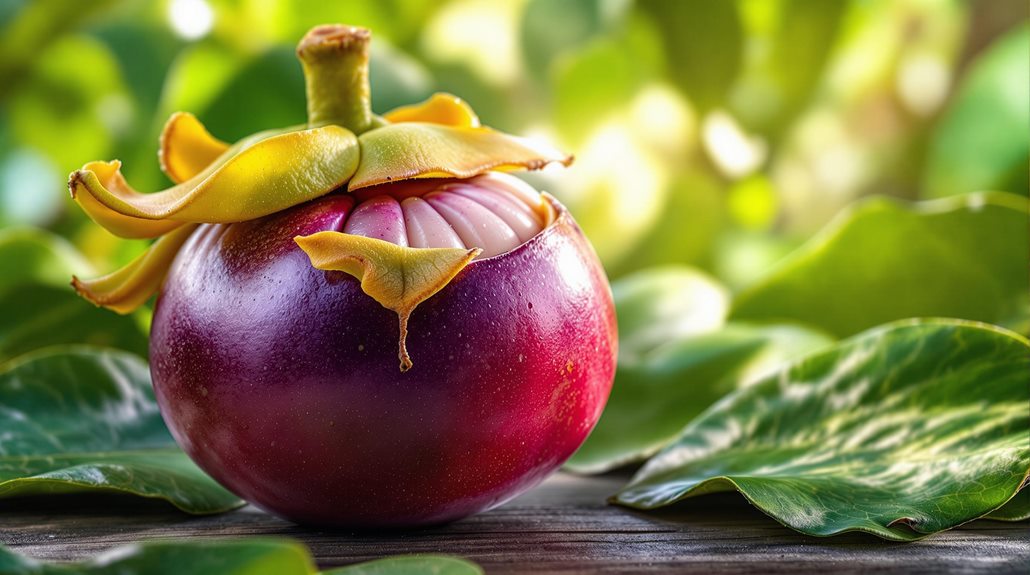
While jackfruit impresses with its size and versatility, mangosteen earns admiration for its regal reputation. Known as the "queen of fruits," mangosteen captivates with its thick, purple rind encasing juicy, white segments. These segments are not only pleasing to the eye but also offer a sweet and tangy flavor that delights the palate. As a tropical fruit, mangosteen hails from Southeast Asia, with Thailand and Indonesia leading its cultivation. Its exotic appeal extends beyond its native regions, making it a sought-after delicacy worldwide.
You'll find mangosteen in different forms, from fresh fruit to invigorating beverages and decadent desserts. Its unique taste profile and health benefits, including antioxidants like xanthones, contribute to its esteemed status. These antioxidants are believed to offer anti-inflammatory and antibacterial properties, adding to the fruit's allure.
Here's a quick breakdown of mangosteen's key features:
| Feature | Description |
|---|---|
| Appearance | Purple rind, white segments |
| Flavor | Sweet and tangy |
| Origin | Southeast Asia (Thailand, Indonesia) |
| Seasonality | Warmer months |
When you encounter mangosteen in tropical fruit markets, don't hesitate to indulge in this seasonal favorite—it truly lives up to its royal title.
Snake Fruit's Scaly Skin
Snake fruit, intriguingly known as salak, stands out with its distinctive reddish-brown, scaly skin reminiscent of snake scales. This unique appearance makes it a curious enhancement to any fruit basket. When you peel away the scaly skin, you'll find a fruit divided into three lobes, much like garlic cloves. Each lobe offers a delightful combination of crunchy texture, sweetness, and a tangy taste, often compared to a blend of honey and pineapple.
Originating from Indonesia, snake fruit is not only exotic but also versatile. You can enjoy it fresh, perhaps incorporating it into your next fruit salad for a burst of flavor. Its crunchy texture complements other fruits beautifully, making it a standout ingredient. If you're feeling adventurous, try it pickled or as a unique dessert component.
Beyond its taste, snake fruit is packed with nutritional benefits. It's rich in fiber, which aids digestion, and loaded with antioxidants and potassium, contributing to general health. This makes it a nutritious choice regardless of whether you're indulging in a sweet snack or crafting a balanced meal. Next time you're exploring unusual fruits, don't overlook the enthralling snake fruit.
Buddha's Hand Citrus
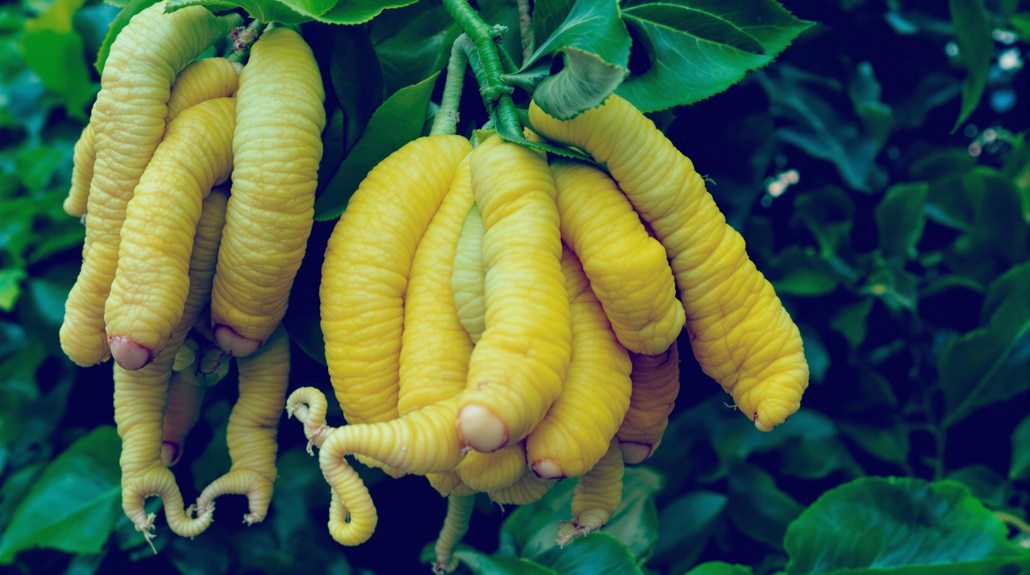
Buddha's Hand, an enchanting citrus fruit, stands out with its unique shape resembling a hand with elongated, finger-like segments. You might find its strong lemon fragrance intriguing, as it's quite different from other citrus fruits. Unlike the usual oranges or lemons, Buddha's Hand contains no pulp or juice, which makes it primarily valued for its zest. In culinary applications, its zest can improve the flavor of dishes and beverages, adding an aromatic touch that's hard to replicate.
When you visit Asian grocery stores, keep an eye out for this distinct fruit, especially in the fall when it's typically harvested. In traditional Asian cultures, Buddha's Hand symbolizes good fortune and is often used for decoration or given as a gift during the New Year.
Here's a quick guide to understanding Buddha's Hand:
| Feature | Description | Usage |
|---|---|---|
| Appearance | Hand-like, elongated fingers | Decorative and symbolic |
| Fragrance | Strong lemon aroma | Culinary zest and flavoring |
| Availability | Found in Asian grocery stores, fall harvest | Symbol of good fortune, gifts |
Whether you're looking to investigate new culinary applications or seeking a symbol of good fortune, Buddha's Hand offers something special.
Horned Melon's Spiky Appeal
Often capturing attention with its striking appearance, the horned melon, also known as kiwano, is a fruit unlike any other. Its spiky skin, bright orange and covered in small, horn-like protrusions, sets it apart from the usual crowd of exotic fruits. The horned melon originates from Sub-Saharan Africa, but you'll find it flourishing in places like New Zealand and California now.
Once you cut through its formidable exterior, you're greeted by the bright green, jelly-like flesh inside. This unique texture is paired with a revitalizing flavor that combines hints of lemon and cucumber. When eating a horned melon, simply slice it in half and scoop out the seeds—it's that easy. You can add it to fruit salads or even use it as a garnish for cocktails, instantly enhancing any dish with its exotic touch.
On the nutritional side, the horned melon is a stellar choice. It's low in calories and high in vitamin C, offering an increase of antioxidants and hydration. So, next time you're browsing through exotic fruits, don't overlook the horned melon. Its spiky appeal is more than just skin-deep—it's a feast for both the eyes and the body.


